Subjunctive form KS2 – Worksheets, examples and how to teach it
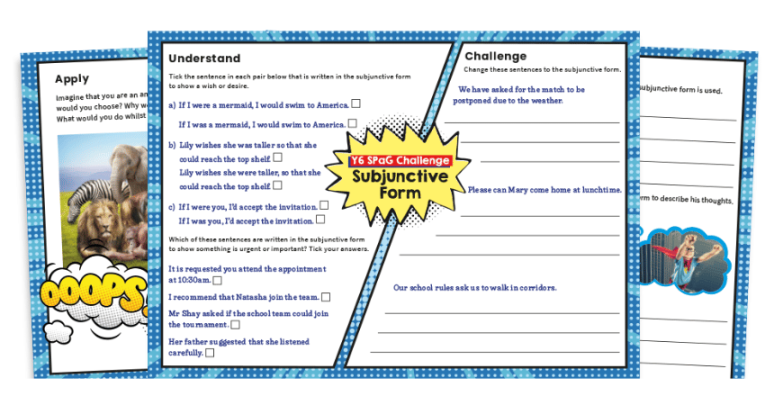
Teaching the subjunctive form to KS2 pupils can seem challenging. However, these resources and activities will give you a helping hand…

- by Teachwire
- Classroom expertise and free resources for teachers

Unlock the mysteries of the subjunctive form in KS2 with these resources and activities…
What is the subjunctive form?
It’s fair to say that not all grammar objectives are made equal. Some, such as using commas to separate items in a list, are easily understood by teachers and pupils alike.
Whereas others, such as the subjunctive, leave us scratching our heads trying to work out what they are and how to explain them to children.
The subjunctive is tricky. It appears as a sentence level objective for children in Year 6 and requires a thorough understanding of prior learning about verbs, subordinating conjunctions, levels of formality and Standard English.
Dreams, possibilities and aspirations
You can use the subjunctive form (or subjunctive mood) to show things that could or should happen (perhaps hypothetically) under certain circumstances. You can use it to show things like hopes, dreams, demands and suggestions.
Imagine you’re making a wish, giving advice, or talking about something that isn’t real yet. That’s when you use the subjunctive form.
As the excellent MC Grammar puts it so catchily, “If your writing’s formal then it’s normal for you to choose and use this mood.”
Expressing importance and commands
The second form of the subjunctive centres on being authoritative. This form of the subjunctive simplifies verbs so that they are in their infinitive form (to go, to be, to dance etc) but without the ‘to’.
It also uses ‘that’ to link the subjunctive clause to the main clause in the sentence:
- We ask that children be able to recite their times tables. (We ask that children are able to recite their times tables.)
- It is recommended that he stay indoors until he is better. (It is recommended that he stays indoors until he is better.)
You may find that you need to spend time identifying the infinitive form of verbs with children. Providing them with a variety of verbs and asking them to write each in the infinitive is a good way to do this.
You can then ask them to use these verbs in model sentences using ‘that’ and the infinitive (without the ‘to’).
Vital to this work is helping children remember that the infinitive of has, had and having is ‘to have’ and that the infinitive of am, are, being, been, is, was, were is ‘to be’.
Subjunctive form examples for KS2
One famous example of the subjunctive form is from an advert: “Should’ve gone to Specsavers.”
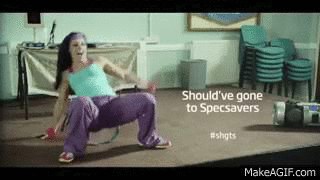
In this scenario, the verb ‘go’ in its past tense, ‘gone’, is modified to ‘should have gone’.
So rather than something definite and concrete like “She has gone to Specsavers”, we get this scenario where she “Should’ve gone to Specsavers”. The slogan highlights a missed opportunity or a better choice that wasn’t made.
Wishes and hopes
Dreams, possibilities and aspirations are ideas that are subject to change. They cannot be pinned down or proven as facts. In formal Standard English, these ideas are expressed using the subjunctive.
This means that the verb ‘to be’ takes the form ‘were’ rather than ‘was’ as it would in other sentences:
If I were a millionaire, I’d buy a racing car.
This use of were instead of was can be confusing to children, who may well start writing phrases such as “I were going to town” in the misbelief that they are using the subjunctive.
To combat this, drawing their attention to the conditional nature of the subjunctive is essential. Point out how the example sentence uses the conditional (subordinating) conjunction ‘if’. This suggests the idea is hypothetical and may never come to fruition.
One way to practise this in the classroom is to display sentences using ‘were’ and ask children to identify whether were is being used to form the subjunctive, the plural past tense of the verb to be or incorrectly:
- If I were a grown-up, I’d go to the cinema every day (subjunctive)
- James and I were riding our bikes (plural past tense)
- Sam were doing his homework (incorrect)
More subjunctive form examples
Advice/suggestions: “It’s important that she study hard.” (This is advice for her to study hard.)
Unreal situations: “If I were you, I would tell the truth.” (But I’m not you.)
The national curriculum gives the following examples of the subjunctive form:
- The school requires that all pupils be honest.
- The school rules demand that pupils not enter the gym at lunchtime.
- If Zoë were the class president, things would be much better.
In the following examples, the italicised verbs are the ones modified by the subjunctive form.
- I suggest you take the rest of the day off.
- Experts recommend eating five pieces of fruit or veg a day.
- I wouldn’t want to be in your position.
- If I were you I’d get that fixed.
- What would you buy first if you won the lottery?
- You must come to the party.
Subjunctive form KS2 worksheets
Subjunctive form Year 6 worksheet

This bright, appealing PDF grammar worksheet from literacy resources website Plazoom is an excellent way to practise and revise using the subjunctive form in Year 6.
Activities include SATs-style questions and opportunities for creative writing responses, with eye-catching images as prompts.
Subjunctive form teaching ideas
Essential prior knowledge
- Ensure children recognise that verbs are having and being words as well as doing words.
- Make sure children recognise which modal verbs indicate uncertainty. Extend this to understanding when modal verbs have been contracted (I’d). Pupils should recognise when modals have been combined with a negative statement (wouldn’t, couldn’t etc).
- Talk to children about the infinitive form of verbs. When inflections are regular e.g. swimming, it is easy to go back to the infinitive (to swim), but irregular past participles eg swam may be confusing to some children. Again, recognising all forms of the verb ‘to be’ is important here.
- Children should recognise subordinating conjunctions such as if and that and appreciate how they affect all the words that follow them in a clause. They should also recall how commas are used to mark subordinate clauses when they appear at the front of sentences.
- Talk about Standard English with children. Explain that Standard English is about grammatical rules such as subjects and verbs agreeing. In the case of the subjunctive, they are rules which make the Standard English sound very formal. Standard English is not about having a particular accent. It’s possible to have informal writing that still uses the rules of Standard English.
Examples of subjunctive form in songs and poems
If you’re looking for examples that use ‘if’ within a subjunctive sentence, there are a range of songs and poems you can study with children and then use as models for writing:
- worship song, If I were a Butterfly
- If I were a Rich Man from Fiddler on the Roof
- If I were a Boy by Beyoncé
- If I were a King by AA Milne
When studying these poems and songs, note that the modal verbs ‘would’, ‘could’ and ‘I’d’ are also frequently used.
Reminding children that these modals reflect the uncertainty of dreams and aspirations will help them form the subjunctive in their own writing.
You may also want to remind them that negative forms of these words such as ‘wouldn’t’ and ‘couldn’t’ are still modal verbs.
Ideas for using the subjunctive form authentically
One of the greatest challenges we face when teaching children grammar, is knowing which types of writing use the feature authentically.
In the case of the were form of the subjunctive you can use it to write simple poems about hypothetical situations:
- If I were a teacher for a day I’d give the children extra play
The subjunctive can also be used to good effect in discursive writing:
- If people were to stop hunting whales…
- If you were to consider the following points…
You can also use it to promote the features of a place or product in persuasive texts:
- If you were lucky enough to visit the rainforest, you would see…
If you’re looking for authentic opportunities for children to use the authoritative form of the subjunctive, you will almost certainly want them to use a highly formal tone.
Try writing letters from people in authority or letters of complaint:
- Dear parents, please ensure that all homework be completed in blue ink
- I request that the item be returned to me
You could also write formal requests to visitors, such as those at a tourist attraction:
- Whilst on the premises, we ask that visitors keep to the paths…
Thank you to Rachel Clarke for these ideas. Rachel is director of Primary English. She trains teachers all over the UK and beyond and is the author of Reading Detectives and Writing Mechanics, both available from Collins.
More subjunctive form resources for KS2
Interactive grammar terminology displays
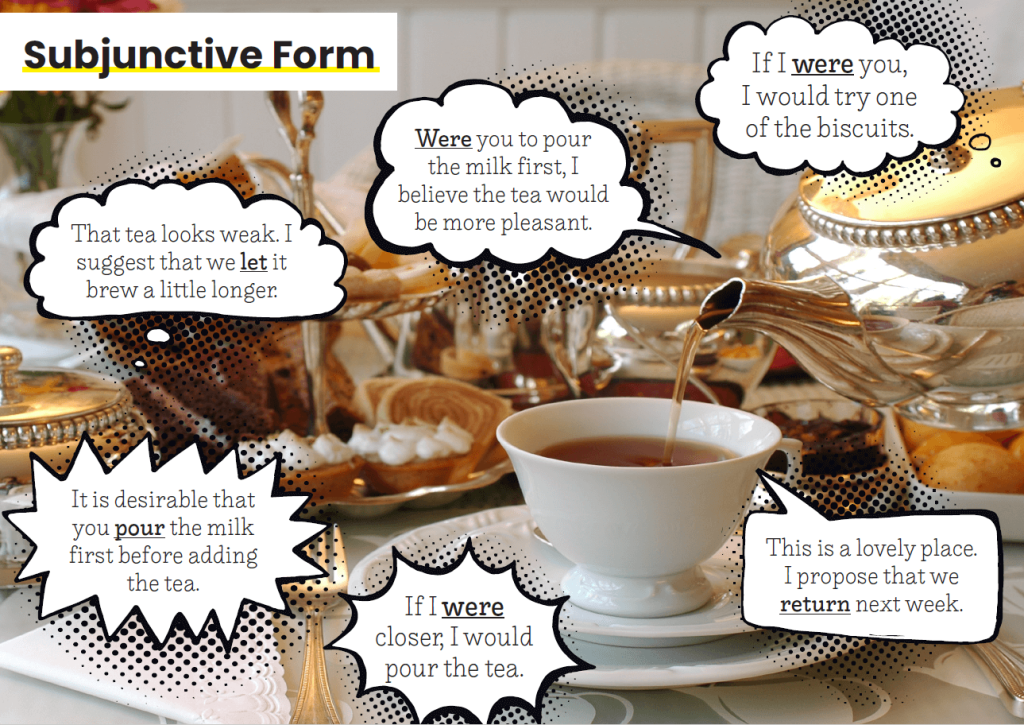
This display pack from Plazoom contains six posters illustrating key grammar terms for KS2 learners using eye-catching images and memorable model sentences, one of which is the subjunctive form.
Copies of the posters without the exemplar sentences are also included, at both A4 and giant sizes, so children can add their own suggestions as part of table work or a wall display.
Subjunctive form worksheets
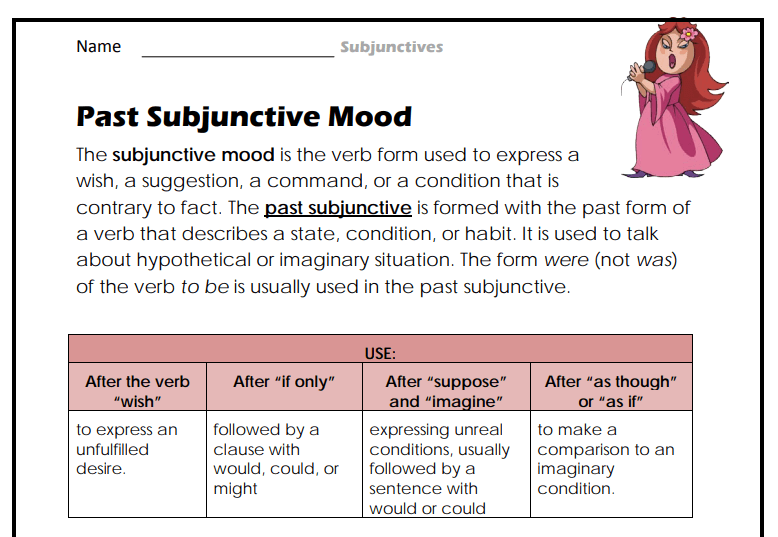
Check out this collection of printable subjunctive mood worksheets. They cover the present subjunctive, past subjunctive and more. They’re all free, and all come with an answer key.
Year 6 subjunctive form scheme of work
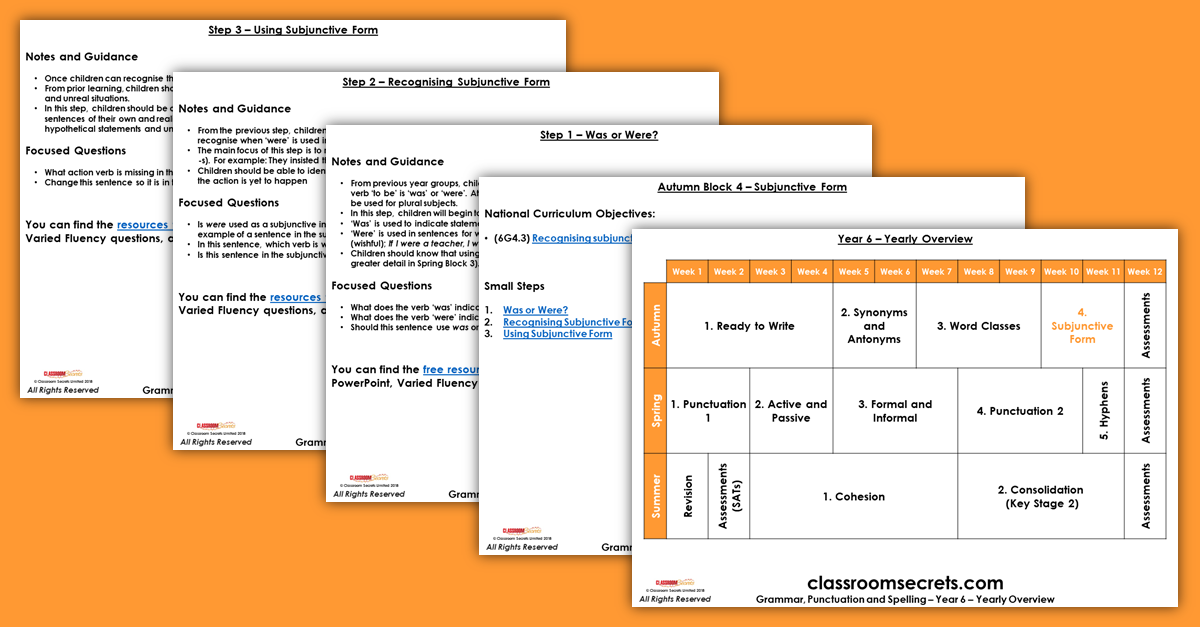
This free scheme of work for Year 6 Grammar, Punctuation and Spelling includes four small steps with guidance for teaching.
It covers ‘was’ or ‘were’?, and helps children recognise and use the subjunctive form.
Subjunctive mood vs indicative mood
If you want to help students understand why ‘was’ and ‘were’ make a difference, this video should help clear things up.
Read advice for teaching SPaG consistently throughout your school.










